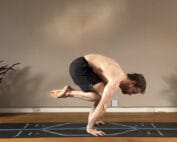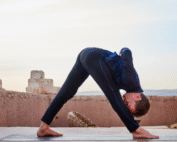
Transform Your Yoga Practice with the Power of Plank Pose
Welcome to the ultimate guide on Plank Pose! Whether new to yoga or a seasoned practitioner, mastering Plank Pose, or Phalakasana, is key to building core strength and stability. This humble yet powerful pose is more than just a core workout—it’s a full-body challenge that enhances physical and mental endurance.
In this guide, we’ll dive deep into the essentials of Plank Pose: from its origin and benefits to a step-by-step guide and advanced variations. Ready to strengthen your core and transform your practice? Let’s get started!
What is Plank Pose?
Plank Pose, or Phalakasana, is a fundamental yoga posture that builds core strength, stability, and endurance. In this pose, your body forms a straight line from head to heels, supported by your hands and toes on the mat. Because of its versatility and effectiveness, it’s a staple in many yoga sequences and fitness routines. Often used as a transition between poses or as a strengthening exercise on its own, the Plank Pose engages multiple muscle groups, including the core, shoulders, arms, and legs.
Plank Pose (Phalakasana)
- Sanskrit Name: Phalakasana
- Pronunciation: fa-la-ka-sa-na
- Meaning of Phalakasana: “Phalaka” means plank or board, symbolising the straight and firm shape of a plank of wood.
Benefits of Plank Pose
- Core Strengthening: Plank Pose is one of the most effective exercises for developing core strength. It targets all the major muscles of the core, including the rectus abdominis, transverse abdominis, and obliques. This helps in building a strong and stable centre, which is crucial for overall movement and balance.
- Improved Posture and Alignment: By engaging the core, shoulders, and legs, Plank Pose helps to stabilise your posture. A strong core supports the spine, which in turn enhances your ability to maintain suitable posture throughout the day. This can alleviate back pain and prevent postural issues.
- Upper Body Strength: Holding the Plank Pose engages the abdominals, shoulders, arms, legs and chest muscles. This not only builds strength in these areas but also prepares the body for more advanced postures like arm balances and inversions.
- Boosts Metabolism: Isometric holds like Plank Pose activate multiple muscle groups simultaneously, leading to an increase in heart rate and calorie burn. This can boost your metabolism, helping in weight management and fat loss over time.
- Supports Spinal Health: A strong core is essential for stabilising the spine. The Plank Pose encourages propealignment and strengthens the muscles supporting the spine, reducing the risk of back injuries and promoting overall spinal health.
- Mental Benefits: Holding Plank Pose requires focus and determination, building mental resilience and mindfulness. It helps in developing a sense of presence and concentration, which can be beneficial both on and off the mat.
These benefits make Plank Pose a versatile and valuable addition to any fitness or yoga routine, offering physical and mental advantages that go beyond just building a strong core.
Steps to Perform Plank Pose

- Starting Position
- Begin on your hands and knees in a tabletop position. Your wrists situated under your shoulders, and your knees under your hips. Spread your fingers and press into the mat.
- Stabilise Your Plank
- Tuck the tailbone under, press through your hands and lift your knees off the ground and straighten the legs. Lean into your hands and practice exploring lightness in the feet by engaging the quadriceps muscles of the upper legs.
- Add Intensity
- Squeeze your glutes and thighs to engage your legs. Press the floor away with your hands to engage your arms and shoulders.
- Hold the Position
- Keep your body steady and maintain a straight line from head to heels. Hold the pose for 20-30 seconds, or as long as you can maintain proper form. Focus on your breath, keeping it steady and smooth.
- Release
- To come out of the pose, gently lower your knees to the mat and return to the tabletop position. Take a moment to rest in Child’s Pose if needed.
Variations of the Plank Pose
- Forearm Plank (Phalakasana on Elbows)
- Description: Instead of balancing on your hands, lower your forearms to the mat with elbows aligned under the shoulders. This variation increases core engagement and reduces wrist strain.
- Benefits: Enhances core stability and is easier on the wrists while still providing a strong workout for the shoulders and core.
- Reverse Plank (Purvottanasana)
- Description: Sit with your legs extended, place your hands behind you with fingers pointing towards your feet, and lift your hips off the ground, forming a straight line from head to heels.
- Benefits: Strengthens the posterior chain, including glutes, hamstrings, and lower back, while also opening up the chest and shoulders.
- Benefits: Adds a balance challenge and increases the demand on the core and glutes, making the pose more dynamic.

- Description: From a standard plank, shift your weight onto one hand and rotate your body to the side, stacking your feet and extending your other arm towards the sky.
- Benefits: Strengthens the obliques, improves balance, and engages the stabilising muscles around the shoulder girdle.
Tips For Beginners
Maintaining proper alignment and listening to your body in Plank Pose is essential. Start with shorter holds, around 10-20 seconds, and gradually build your strength and endurance. If you experience discomfort in your wrists or lower back, modify the pose by lowering your knees to the mat or practising an incline plank with your hands on a bench or step. Remember, quality over quantity is key—focus on proper form rather than how long you can hold the pose.
Safety and Precautions for Plank Pose
- Wrist Support: If you have wrist pain or discomfort, try practising on your forearms or using fists instead of flat palms to reduce strain on the wrists.
- Shoulder Alignment: Keep your shoulders stacked directly over your wrists or elbows to avoid undue stress on the shoulder joints.
- Neck Alignment: Look down at the mat to keep your neck neutral, avoiding strain by not dropping your head or looking up.
Final Thought
Ready to take your Plank Pose to the next level and build a stronger core? Join Dav Jones Yoga on Patreon for comprehensive classes that cater to all experience levels. With step-by-step guidance and tailored practice plans, you’ll deepen your understanding and enhance your strength, stability, and balance. Whether you’re perfecting your basics or exploring advanced variations, Dav’s mentorship programs offer 1-2-1 teaching with Dav supporting you every step of the way. Pop us a message through the ‘contact us’ tab.









